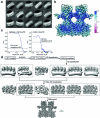Activation of human STING by a molecular glue-like compound
- PMID: 37828400
- PMCID: PMC10907298
- DOI: 10.1038/s41589-023-01434-y
Activation of human STING by a molecular glue-like compound
Abstract
Stimulator of interferon genes (STING) is a dimeric transmembrane adapter protein that plays a key role in the human innate immune response to infection and has been therapeutically exploited for its antitumor activity. The activation of STING requires its high-order oligomerization, which could be induced by binding of the endogenous ligand, cGAMP, to the cytosolic ligand-binding domain. Here we report the discovery through functional screens of a class of compounds, named NVS-STGs, that activate human STING. Our cryo-EM structures show that NVS-STG2 induces the high-order oligomerization of human STING by binding to a pocket between the transmembrane domains of the neighboring STING dimers, effectively acting as a molecular glue. Our functional assays showed that NVS-STG2 could elicit potent STING-mediated immune responses in cells and antitumor activities in animal models.
© 2023. The Author(s).
Conflict of interest statement
All authors (except otherwise noted) are or were at the time of their involvement with the research employees of Novartis Institute for BioMedical Research and may hold stock in Novartis. S.M.M. and K.E.S. were at the time of their involvement with the research employees of Aduro Biotech and may hold stock in Aduro (now Chinook Therapeutics).
Figures











Comment in
-
Molecular glue-like STING activator.Nat Rev Drug Discov. 2023 Dec;22(12):955. doi: 10.1038/d41573-023-00173-y. Nat Rev Drug Discov. 2023. PMID: 37907755 No abstract available.
References
Publication types
MeSH terms
Substances
Grants and funding
LinkOut - more resources
Full Text Sources
Research Materials

